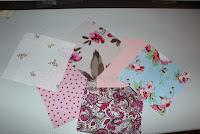So this page is just things I have made and done. But I aim to add things regularly and am sure I will refer to them in blog posts. I will try to include the not so good attempts as I'm not tooooo proud to admit when I've done wrong (just don't tell my husband I said that as I have worked for 13 years towards the premise that I am never wrong ;p)
*This is an update (April 2014) of some of the things I, Katie, have done. Firstly I attempted to re-cover our dining room chairs as they had gotten 'mucky'. Their original cream upholstery wasn't appropriate for our young family and so I purchased some fabric from ebay. Admittedly, that was 8 months ago but at £15 including postage for 15 meters, I thought it was worth the punt. The rest I will keep brief and try and let the pictures explain.
I used the seat as a template for the new fabric covering.
On the first one I used normal scissors but on the successive ones I used pinking shears to cut the fabric to reduce fraying.
Starting at the top of the seat, I stretched the fabric, mindful of the grain that the fabric was running in, and stapled. I then stapled on the other side of the seat keeping the fabric taut and in line. I was careful to avoid the screw holes for when I replaced the seat onto the chair.
I repeated the stretching and stapling on the sides and then worked my way across the top, then bottom. Leaving 2' at the corners, I then moved onto the sides.
 At the corners, I took my time to fold the fabric neatly- first at the side and then over from the top and bottom so that looking straight on, the fold of the fabric was flush with the side of the seat.
At the corners, I took my time to fold the fabric neatly- first at the side and then over from the top and bottom so that looking straight on, the fold of the fabric was flush with the side of the seat.
One down, 5 more to go!
So that these seats don't get ruined, I also made 3 seat pads which were thinly quilted. I used a walking foot on my machine and sewed a random pattern to attach the wadding to the cover. I anticipate these will be washed frequently so the wadding will remain in place due to the quilted effect. I attached straps at the back to tie them to the back of the chairs and to hold them in place under wriggly bottoms.
*End of April 2014 insert.
 |
| I saw a lovely quilt in Mollie makes issue 7 http://chloeowenstextiledesign.blogspot.co.uk/2012/01/over-rainbow-mollie-makes.html and thought I'd have a go too- only I didn't have any wadding so made it into a wall hanging. I liked it so much, that I didn't stop there :D |
 |
| I made coordinating bunting ( rain-dropey like), a pillow case (not pictured) and a little cloud cushion |
 |
| This is a very soft velour like white fabric which I felt was akin/ reminiscent of a cloud . It has a blue back though and the edge is a patchwork of the materials from the hanging and bunting. |
 |
| Some close ups of the flags but I totally missed the piece of red thread (but my camera didn't!) |
 |
| And this is the finished product- a small lap quilt which fits well over the back of a chair too (see first pic). |
 |
| This was a combination of gorgeous materials I had in blue and white. I love blue floral prints and had been collecting bits with a quilt like this in mind. I did the darker border and then a floral one which continues onto the back and then there is a large floral piece. I used extra thick wadding (about 7mm instead of the usual 2mm) It is single bed sized or can go on the back of a setee or end of of a double as a runner. Already have people wanting to buy it but I have kept a hold of it for the fair I have organised as I want some larger pieces to take with me to hopefully pick up some commission work :D |
I chose a sheet that I purchased in a charity shop and decided I would attempt a cover up job. I have never made a cover before but after looking at the structure of the cushions, a simple envelope looked as though it would work.
I laid the material on the floor and then placed the cushion on top. Pinning the material in place with enough excess for the weight of a person pulling at the edges, I then turned it inside out and sewed up the sides.
It fit over the cushions easily but to prevent it from gaping at the sides, or flapping open, I fixed elastic across the back so that I could stretch it over the chair without fiddly fastenings and saving me from having to create holes etc.
I used 1cm width elastic and reinforced the stitching several times on the sewing machine.
The moment of truth- it fitted. I didn't want a repeat of the mixing experiment so felt it was only right to put the chair in my room. Besides, it matches everything and will be useful in the future months for those night-time feeds. It probably took 1- 11/2 hours and has restored this chair. I am very pleased with myself :D

























No comments:
Post a Comment